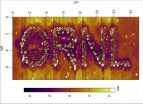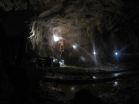Dutch barnacle geese have more active immune system than same species in the North
2014-12-17
(Press-News.org) Bird migration is an impressive phenomenon, but why birds often travel huge distances to and from their breeding grounds in the far North is still very unclear. Suggestions include that the birds profit from longer daylight hours, or that there are fewer predators. Researchers from the University of Groningen and the NIOO-KNAW Vogeltrekstation, the Dutch centre for bird migration and demographics, have discovered a new explanation.
They investigated barnacle geese breeding on Spitsbergen and compared them with birds of the same species that did not migrate but stayed in the Netherlands all year round.
Invest less in immune system
The birds on Spitsbergen appear to invest much less energy in their immune systems, particularly the part responsible for general resistance to disease. The researchers suspect that this might be because there are far fewer pathogens in the North than here in the Netherlands.
More energy available for reproduction
By investing less in their immune systems, the birds have more energy available for reproduction and changing their plumage. The birds that breed in the Netherlands do not have this luxury. In order to defend themselves against pathogens like bird flu, their immune systems work about four times as hard during the entire summer than those of the same species in the North. Thus birds appear able to adjust their immune systems according to the risk of catching a disease.
INFORMATION:
[Attachments] See images for this press release:

ELSE PRESS RELEASES FROM THIS DATE:
2014-12-17
DURHAM, N.C. -- The best way to protect wild spinner dolphins in Hawaii while also maintaining the local tourism industry that depends on them is through a combination of federal regulations and community-based conservation measures, finds a new study from Duke University.
Each year, hundreds of thousands of tourists to Hawaii pay to have up-close encounters with the animals, swimming with them in shallow bays the dolphins use as safe havens for daytime rest. But as the number of tours increases, so do the pressures they place on the resting dolphins.
The Duke study ...
2014-12-17
A new catalytic process is able to convert what was once considered biomass waste into lucrative chemical products that can be used in fragrances, flavorings or to create high-octane fuel for racecars and jets.
A team of researchers from Purdue University's Center for Direct Catalytic Conversion of Biomass to Biofuels, or C3Bio, has developed a process that uses a chemical catalyst and heat to spur reactions that convert lignin into valuable chemical commodities. Lignin is a tough and highly complex molecule that gives the plant cell wall its rigid structure.
Mahdi ...
2014-12-17
A close look at the night sky reveals that stars don't like to be alone; instead, they congregate in clusters, in some cases containing as many as several million stars. Until recently, the oldest of these populous star clusters were considered well understood, with the stars in a single group having formed at different times, over periods of more than 300 million years. Yet new research published online today in the journal Nature suggests that the star formation in these clusters is more complex.
Using data from the Hubble Space Telescope, a team of researchers at the ...
2014-12-17
OAK RIDGE, Tenn., Dec. 17, 2014--Scientists at the Department of Energy's Oak Ridge National Laboratory have used advanced microscopy to carve out nanoscale designs on the surface of a new class of ionic polymer materials for the first time. The study provides new evidence that atomic force microscopy, or AFM, could be used to precisely fabricate materials needed for increasingly smaller devices.
Polymerized ionic liquids have potential applications in technologies such as lithium batteries, transistors and solar cells because of their high ionic conductivity and unique ...
2014-12-17
UCLA researchers have developed a lens-free microscope that can be used to detect the presence of cancer or other cell-level abnormalities with the same accuracy as larger and more expensive optical microscopes.
The invention could lead to less expensive and more portable technology for performing common examinations of tissue, blood and other biomedical specimens. It may prove especially useful in remote areas and in cases where large numbers of samples need to be examined quickly.
The microscope is the latest in a series of computational imaging and diagnostic devices ...
2014-12-17
VIDEO:
It's official -- our holiday lights are so bright we can see them from space. Thanks to the VIIRS instrument on the Suomi NPP satellite, a joint mission between NASA...
Click here for more information.
Even from space, holidays shine bright.
With a new look at daily data from the NOAA/NASA Suomi National Polar-orbiting Partnership (Suomi NPP) satellite, a NASA scientist and colleagues have identified how patterns in nighttime light intensity change during major holiday ...
2014-12-17
The sun emitted a mid-level solar flare, peaking at 11:50 p.m. EST on Dec. 16, 2014. NASA's Solar Dynamics Observatory, which watches the sun constantly, captured an image of the event. Solar flares are powerful bursts of radiation. Harmful radiation from a flare cannot pass through Earth's atmosphere to physically affect humans on the ground, however -- when intense enough -- they can disturb the atmosphere in the layer where GPS and communications signals travel.
To see how this event may affect Earth, please visit NOAA's Space Weather Prediction Center at http://spaceweather.gov, ...
2014-12-17
In the first real-world trial of the impact of patient-controlled access to electronic medical records, almost half of the patients who participated withheld clinically sensitive information in their medical records from some or all of their health care providers.
This is the key finding of a new study by researchers from Clemson University, the Regenstrief Institute, Indiana University School of Medicine and Eskenazi Health published in the Journal of General Internal Medicine.
Kelly Caine, assistant professor in Clemson's School of Computing, and colleagues at Clemson ...
2014-12-17
A team of scientists, led by the University of Toronto's Barbara Sherwood Lollar, has mapped the location of hydrogen-rich waters found trapped kilometres beneath Earth's surface in rock fractures in Canada, South Africa and Scandinavia.
Common in Precambrian Shield rocks - the oldest rocks on Earth - the ancient waters have a chemistry similar to that found near deep sea vents, suggesting these waters can support microbes living in isolation from the surface.
The study, to be published in Nature on December 18, includes data from 19 different mine sites that were ...
2014-12-17
Chemical modifications to DNA's packaging -- known as epigenetic changes -- can activate or repress genes involved in autism spectrum disorders (ASDs) and early brain development, according to a new study to be published in the journal Nature on Dec. 18.
Biochemists from NYU Langone Medical Center found that these epigenetic changes in mice and laboratory experiments remove the blocking mechanism of a protein complex long known for gene suppression, and transitions the complex to a gene activating role instead.
Researchers say their findings represent the first link ...
LAST 30 PRESS RELEASES:
[Press-News.org] Dutch barnacle geese have more active immune system than same species in the North






